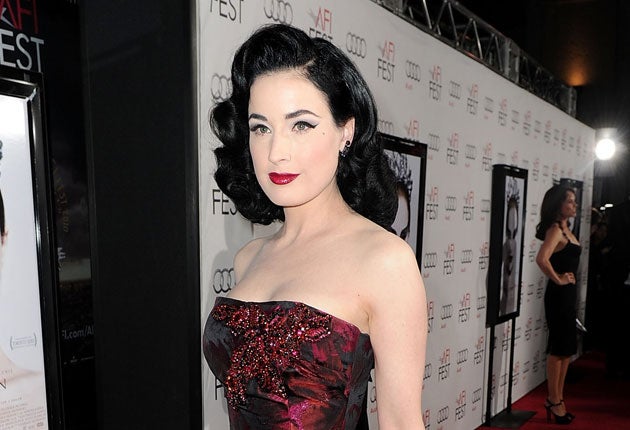Popular culture goes back to the Thirties
Suddenly, austerity – and its twin, nostalgia – are breaking out all over

Your support helps us to tell the story
From reproductive rights to climate change to Big Tech, The Independent is on the ground when the story is developing. Whether it's investigating the financials of Elon Musk's pro-Trump PAC or producing our latest documentary, 'The A Word', which shines a light on the American women fighting for reproductive rights, we know how important it is to parse out the facts from the messaging.
At such a critical moment in US history, we need reporters on the ground. Your donation allows us to keep sending journalists to speak to both sides of the story.
The Independent is trusted by Americans across the entire political spectrum. And unlike many other quality news outlets, we choose not to lock Americans out of our reporting and analysis with paywalls. We believe quality journalism should be available to everyone, paid for by those who can afford it.
Your support makes all the difference.A renaissance in popular culture from the austerity period that began in the 1930s is seeing theatres, cinemas and the small screen packed with the grit, grimness and escapist Technicolor of the pre-war and subsequent wartime years. Fashion, from high-end Prada to the online retailer ASOS, and hairstylists, are also picking up on the theme.
Sarah Churchwell, a cultural commentator and academic at the University of East Anglia, said that each decade's art subconsciously reflects the moods, fears and anxieties of the time. "There are many similarities between now and the 1930s," she said. "Not just economically. Both periods saw shifts in global power and instability. The response to the economic depression came not just in escapism, but also anxiety and psychological depression."
Susan Currell, a senior lecturer in American Studies at Sussex University, added: "I think people want to escape, but also to look at the reality of what's happening. The bestselling book of the 1930s was Gone With the Wind, and that looked back to a previous period of hardship. Even with escapism, however, there's a response to austerity. The Wizard of Oz is escapist, but it's also about returning to how you were."
Film
Hollywood can be relied on for a couple of hours of fantasy, but the Brits are made of sterner stuff. Colin Firth is winning plaudits for The King's Speech, out next month, about King George VI's ascension to the throne in 1936. An adaptation of Brighton Rock, Graham Greene's 1938 novel, will be released in February. Hollywood, however, is preparing to bring the 1930s radio hero from The Green Hornet to the big screen, along with Green Lantern, based on the comic-book hero who debuted in 1940. The much-anticipated Tintin from Steven Spielberg and Peter Jackson, based on three 1940s comic books, is also due out next year.
Theatre
Theatre-lovers are either escaping the gloom or confronting it head on in the West End, as grimy drama from the 1930s vies with light escapist farce from the period. Men Should Weep, set in a 1930s Glasgow slum and written in 1947, will be followed at the National next year by Clifford Odets' 1938 play Rocket to the Moon. Also in – or about to be in – the West End are J B Priestley's 1938 farce When We Are Married; Noël Coward's 1941 comedy Blithe Spirit; Lillian Hellman's 1934 drama The Children's Hour, which will star Keira Knightley and Elisabeth Moss; Tennessee Williams' 1944 play The Glass Menagerie, and Andrew Lloyd Webber's musical version of the 1939 film The Wizard of Oz.
Fashion
Hard times are also being reflected on the high street. "The 1930s look is right for today because, post-recession, more people are looking for investment pieces and classics, such as stripes, that won't date," says Harper's Bazaar. "The look is elegant, sophisticated and very feminine. In times of financial difficulties, people go that extra mile to look respectable and elegantly dressed, which in turn helps to lift the nation's mood."
Dance
Ballroom dancing is enjoying a boom thanks to Strictly Come Dancing, but couples are also flocking to genteel tea dances and trying their hand (or feet) at the gravity-defying Lindy Hop, a 1930s precursor to jive. Simon Selmon, of the London Swing Dance Society, said: "There's been a resurgence in Lindy Hop over the past couple of years. It's part of the growing interest in vintage, burlesque and cabaret."
Hairstyles
Men were serious in the 1930s and wore short, back and sides. That look is back, according to Jerome Hilton of award-winning stylists Hair and Jerome in London. Men such as George Clooney and Tobey Maguire are looking to former style icons such as Robert Montgomery and William Powell for inspiration. "Men now take a lot of care about how they look and I have been styling my clients in 1930s looks for a while. We can do a slick side parting with Brilliantine for the office, then create finger waves for a night out."
Television
The small screen is also turning to the austere decades for inspiration. Upstairs, Downstairs, the classic 1970s ITV drama about life in a London townhouse, is being revived by the BBC, with the story being picked up in 1936. Christopher and His Kind, a biopic of the writer Christopher Isherwood, predominately set in 1930s Berlin, is also coming to the BBC, as is South Riding, a saga set in 1930s Yorkshire, based on Winifred Holtby's novel and adapted by Andrew Davies.
Join our commenting forum
Join thought-provoking conversations, follow other Independent readers and see their replies
Comments